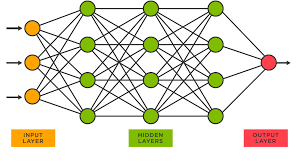Neural Network Regression: Understanding the Basics
Neural network regression is a powerful technique in the field of machine learning that is used to predict continuous values based on input data. Unlike classification tasks, where the goal is to assign a label to each input, regression tasks involve predicting a numerical value.
At the core of neural network regression is the neural network model, which is inspired by the structure and function of the human brain. The model consists of interconnected layers of artificial neurons that process input data and generate output predictions. In regression tasks, the output layer typically consists of a single neuron that produces the predicted numerical value.
One key component of neural network regression is the loss function, which measures how well the model’s predictions match the actual target values in the training data. During training, the model adjusts its internal parameters using optimization algorithms to minimize the loss function and improve its predictive accuracy.
Neural network regression offers several advantages over traditional regression techniques. One major benefit is its ability to capture complex non-linear relationships in data, making it well-suited for tasks with intricate patterns and dependencies. Additionally, neural networks can automatically learn relevant features from raw input data, reducing the need for manual feature engineering.
To build an effective neural network regression model, careful consideration must be given to various factors such as network architecture, activation functions, regularization techniques, and hyperparameters tuning. Cross-validation and validation datasets are commonly used to evaluate model performance and prevent overfitting.
In conclusion, neural network regression is a versatile and powerful approach for predicting continuous values from input data. By leveraging advanced techniques in deep learning and optimization algorithms, researchers and practitioners can develop accurate models that excel in a wide range of regression tasks.
Seven Advantages of Neural Network Regression: From Capturing Non-Linearities to Scalable Architectures
- Capable of capturing complex non-linear relationships in data
- Automatically learns relevant features from raw input data
- Reduces the need for manual feature engineering
- Versatile and adaptable to a wide range of regression tasks
- Provides high predictive accuracy when properly trained and tuned
- Can handle large datasets with high dimensionality effectively
- Allows for scalability and flexibility in model architecture
Three Key Challenges of Neural Network Regression: Complexity, Overfitting, and the Demand for Computational Resources
Capable of capturing complex non-linear relationships in data
Neural network regression stands out for its remarkable ability to capture intricate non-linear relationships within data. Unlike traditional regression methods that may struggle with complex patterns, neural networks excel at recognizing and modeling these sophisticated dependencies. By leveraging multiple layers of interconnected neurons, neural networks can effectively learn and represent the nuanced interactions and correlations present in the data, making them a powerful tool for tasks requiring a deeper understanding of intricate relationships.
Automatically learns relevant features from raw input data
One of the key advantages of neural network regression is its ability to automatically learn relevant features from raw input data. Traditional regression techniques often require manual feature engineering, where domain knowledge and expertise are needed to extract meaningful features from the data. In contrast, neural networks can autonomously identify and extract important patterns and relationships in the input data, allowing for more efficient and effective modeling without the need for extensive preprocessing. This capability not only saves time and effort but also enables neural network regression models to adapt to complex datasets with intricate structures, ultimately enhancing their predictive performance and generalization capabilities.
Reduces the need for manual feature engineering
One significant advantage of neural network regression is its capability to reduce the need for manual feature engineering. Traditional machine learning models often require extensive preprocessing and selection of relevant features from raw data to improve performance. In contrast, neural networks can autonomously learn and extract essential features directly from the input data during training. This automated feature learning process not only saves time and effort for data scientists but also allows neural network regression models to effectively capture intricate patterns and relationships in complex datasets without relying heavily on human intervention.
Versatile and adaptable to a wide range of regression tasks
Neural network regression stands out for its versatility and adaptability, making it a valuable tool for a diverse array of regression tasks. Whether the task involves predicting stock prices, housing values, or customer preferences, neural networks can effectively model complex relationships and patterns in the data. By adjusting the network architecture, hyperparameters, and training strategies, neural network regression can be tailored to suit the specific requirements of different applications, showcasing its flexibility and robustness in handling a wide range of regression challenges.
Provides high predictive accuracy when properly trained and tuned
Neural network regression shines in its ability to deliver exceptional predictive accuracy when meticulously trained and finely tuned. By leveraging sophisticated optimization algorithms and deep learning techniques, neural networks can effectively capture complex patterns in data, leading to precise and reliable predictions. When the model parameters are carefully adjusted and validated through rigorous training processes, neural network regression emerges as a formidable tool for achieving high levels of predictive accuracy in a wide range of applications.
Can handle large datasets with high dimensionality effectively
Neural network regression excels in handling large datasets with high dimensionality effectively, making it a valuable tool for complex data analysis tasks. The inherent ability of neural networks to learn intricate patterns and relationships within vast amounts of data allows them to process and extract meaningful insights from massive datasets efficiently. By leveraging their capacity to capture non-linear relationships, neural network regression models can effectively navigate high-dimensional data spaces, uncovering valuable information that may be challenging for traditional regression techniques to discern. This capability makes neural network regression a powerful solution for tasks that involve processing extensive datasets with numerous variables, enabling researchers and practitioners to derive accurate predictions and valuable insights from complex data structures.
Allows for scalability and flexibility in model architecture
Neural network regression offers the pro of allowing scalability and flexibility in model architecture. This means that neural networks can be easily adapted and expanded to accommodate varying complexities of data and tasks. Researchers and practitioners have the freedom to adjust the number of layers, neurons per layer, activation functions, and other architectural components to suit the specific requirements of their regression problem. This scalability and flexibility empower users to build customized models that can effectively handle diverse datasets and deliver accurate predictions in a wide range of applications.
Complexity
One significant drawback of neural network regression is its inherent complexity, which can present challenges in interpreting and understanding the model’s decision-making process. Due to the intricate network architecture and numerous interconnected layers of artificial neurons, neural network regression models often operate as “black boxes,” making it difficult for users to discern the underlying logic behind the predictions. This lack of transparency can hinder trust in the model’s outputs and pose obstacles in identifying potential biases or errors that may impact the accuracy and reliability of the predictions.
Overfitting
Overfitting is a significant drawback of neural network regression, as these models have a tendency to memorize noise and outliers in the training data, rather than capturing the underlying patterns and relationships. This phenomenon results in a model that performs impressively on the training dataset but struggles to make accurate predictions on new, unseen data. The lack of generalization ability caused by overfitting can severely impact the model’s predictive performance and reliability in real-world applications. Preventing overfitting in neural network regression requires careful regularization techniques, appropriate model complexity, and sufficient validation strategies to ensure robust performance across different datasets.
Computational resources
One notable drawback of neural network regression is the heavy demand for computational resources during the training process. Building and training neural network regression models necessitate substantial processing power and memory capacity, leading to high costs and time investments. The need for specialized hardware, such as GPUs, to accelerate computations further adds to the expenses associated with developing these models. Moreover, longer training times due to the complexity of neural networks can hinder rapid experimentation and deployment of regression solutions, making it a challenging aspect for organizations with limited resources or tight deadlines.



